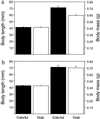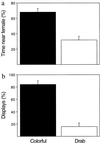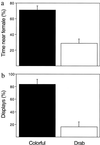Male mate choice selects for female coloration in a fish
- PMID: 11606720
- PMCID: PMC60840
- DOI: 10.1073/pnas.211439298
Male mate choice selects for female coloration in a fish
Abstract
Although sexual selection theory has proved successful in explaining a wide array of male ornaments, the function of ornaments occurring in females is largely unknown. Traditionally, female ornaments have been considered nonfunctional, being merely a genetically correlated response to selection for male ornamentation. However, this hypothesis is only relevant to species in which the ornament is basically the same in the two sexes. Alternatively, female ornaments may be influenced by selection acting directly on the females, either through female-female competition or male choice. We tested the latter hypothesis in mate-choice experiments with two-spotted gobies (Gobiusculus flavescens). In this small marine fish, females have bright yellow-orange bellies during the breeding season, a conspicuous trait that is not present in males. We conducted two aquarium experiments to test whether males preferred to mate with more colorful females. In the first experiment, males had a choice between two females that varied in natural coloration (and belly roundness). In the second experiment, we manipulated belly coloration and kept roundness constant. Males spent more time with colorful than with drab females in both experiments and also performed far more courtship displays toward colorful females. Our study provides experimental evidence that males prefer ornamented females in a fish that is not sex-role reversed, supporting the hypothesis that female ornamentation is sexually selected.
Figures




Comment in
-
Sex roles, ornaments, and evolutionary explanation.Proc Natl Acad Sci U S A. 2001 Nov 6;98(23):12857-9. doi: 10.1073/pnas.241503598. Proc Natl Acad Sci U S A. 2001. PMID: 11698673 Free PMC article. No abstract available.
References
-
- Lande R. Evolution (Lawrence, Kans) 1980;34:292–305. - PubMed
-
- Lande R. In: Sexual Selection: Testing the Alternatives. Bradbury J W, Andersson M B, editors. New York: Wiley; 1987. pp. 83–95.
-
- West-Eberhard M J. Proc Amer Phil Soc. 1979;123:222–234.
-
- West-Eberhard M J. Q Rev Biol. 1983;55:155–183.
Publication types
MeSH terms
LinkOut - more resources
Full Text Sources

